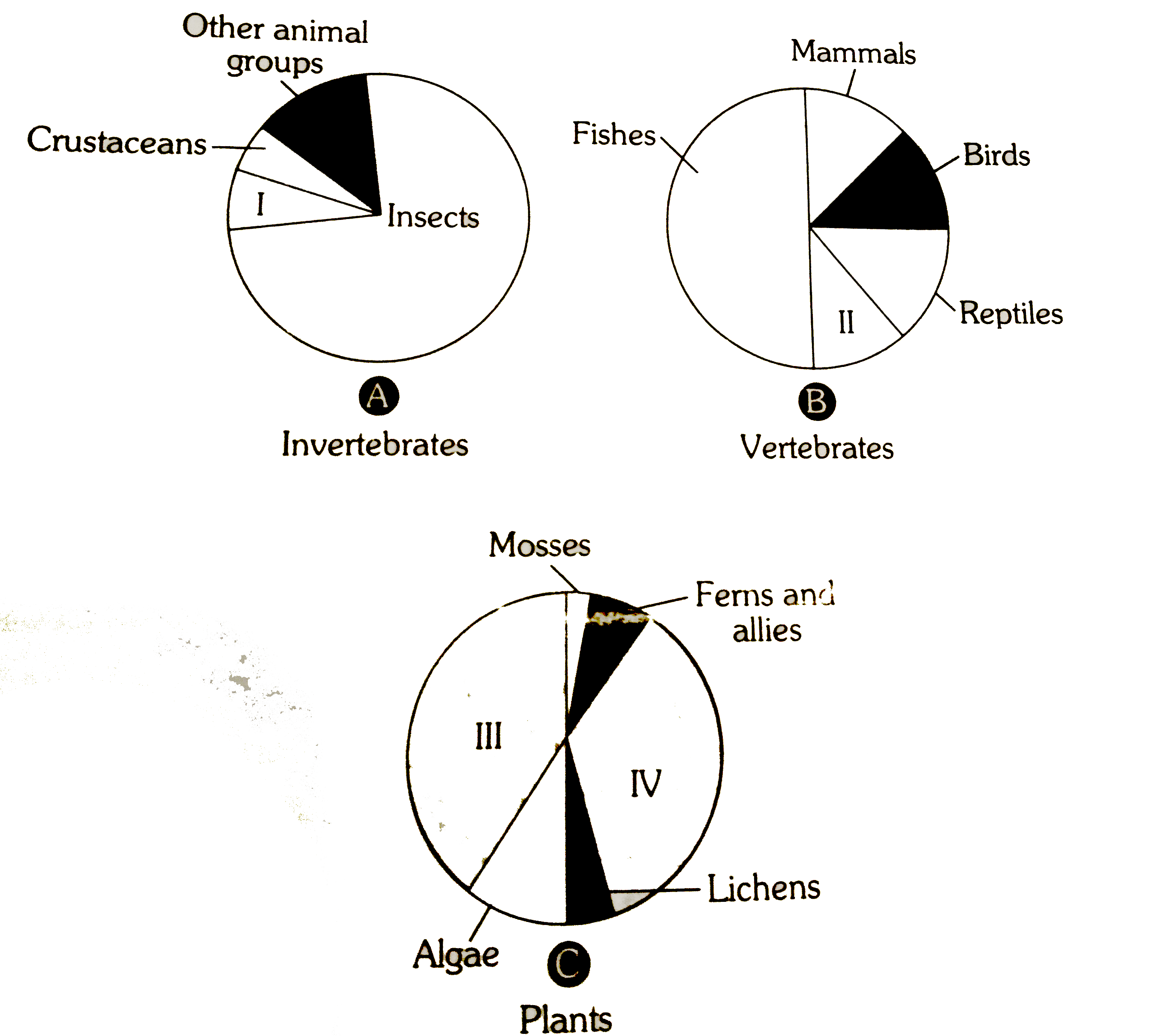The given pie diagram represents the proportionate number of species of major taxa of vertebrates. Identify the group A and B.

A = Reptiles, B = Birds
A - Fish, B-Birds
A-Birds, B - Fish
A-Birds, B-Reptiles
The correct Answer is:B
Among vertebrates, fish account for the maximum share with approximately 26,959 species. Birds have 9,700 identified species and reptiles have 7,150 species.
Topper's Solved these Questions
- BIODIVERSITY & CONSERVATIONBOOK - NCERT FINGERTPS ENGLISHCHAPTER - BIODIVERSITY & CONSERVATIONEXERCISE - HOTS
5 Videos
- BIODIVERSITY & CONSERVATIONBOOK - NCERT FINGERTPS ENGLISHCHAPTER - BIODIVERSITY & CONSERVATIONEXERCISE - NCERT (EXEMPLAR PROBLEMS
20 Videos
- BIOTECHNOLOGY - PRINCIPLES AND PROCESSESBOOK - NCERT FINGERTPS ENGLISHCHAPTER - BIOTECHNOLOGY - PRINCIPLES AND PROCESSESEXERCISE - Biotechnology - Principles And Processes
139 Videos
Similar Questions
Knowledge Check
Given pie diagram represents the proportionate number of species of major groups of invertebrates. Identify the groups A and B.
 AA=Insects, B=MolluscsBA = Molluscs, B = InsectsCA = Insects, B = AnnelidsDA = Molluscs, B = Annelids
AA=Insects, B=MolluscsBA = Molluscs, B = InsectsCA = Insects, B = AnnelidsDA = Molluscs, B = AnnelidsThe given pie diagram represents the proportionate number of species of major taxa of plants. Select the incorrect statements regarding the achloro-
(i) A reprsents the achloro phyllous, heterotrophic, eucaryotic organisms with chitinous cell walls.
(ii) B represents the members of Kingdom Monera, e.g., bacteria and cyanobacteria.
(iii) B represents those seed plants in which seeds are enclosed inside fruits.
A and B represents gymnosperm and angiosperms respectively.
 A(i) and (iv)B(ii) and (iv)C(i) and (iii)D(ii), (iii) and (iv)
A(i) and (iv)B(ii) and (iv)C(i) and (iii)D(ii), (iii) and (iv)The given pie diagram represents the proportionate number of species of major taxa of plants. Select the incorrect statements regarding the achloro-
(i) A reprsents the achloro phyllous, heterotrophic, eucaryotic organisms with chitinous cell walls.
(ii) B represents the members of Kingdom Monera, e.g., bacteria and cyanobacteria.
(iii) B represents those seed plants in which seeds are enclosed inside fruits.
A and B represents gymnosperm and angiosperms respectively.
 A(i) and (iv)B(ii) and (iv)C(i) and (iii)D(ii), (iii) and (iv)
A(i) and (iv)B(ii) and (iv)C(i) and (iii)D(ii), (iii) and (iv)
Identify the groups of organism marked A and B in the given pie diagram representing the proportionate number of species of major taxa of plants.

View SolutionThe given pie diagram represents the proportionate number of species of major taxa of plants. Select the incorrect statements regarding the achloro-
(i) A reprsents the achloro phyllous, heterotrophic, eucaryotic organisms with chitinous cell walls.
(ii) B represents the members of Kingdom Monera, e.g., bacteria and cyanobacteria.
(iii) B represents those seed plants in which seeds are enclosed inside fruits.
A and B represents gymnosperm and angiosperms respectively.

View SolutionGiven below are pie diagrams A, B and C related to proportionate number of species of major taxa of invertebrates, vartebrates and plants respectively. Critically study and fill in the blanks (a), (b), (c ) and (d).

View SolutionThe following are pie diagrams A, B and C related to proportionate number of species of major taxa of invertebrates, vertebrates and plants repectively. Study and select the right option in which all the blanks I, II, III and IV are correctly identified

View SolutionGlobal biodiversity representing proportionate number of species of major taxa of invertebrates, vertbrates and plants are given below , Identify I,II and III by selecting the correct option :

View Solution
